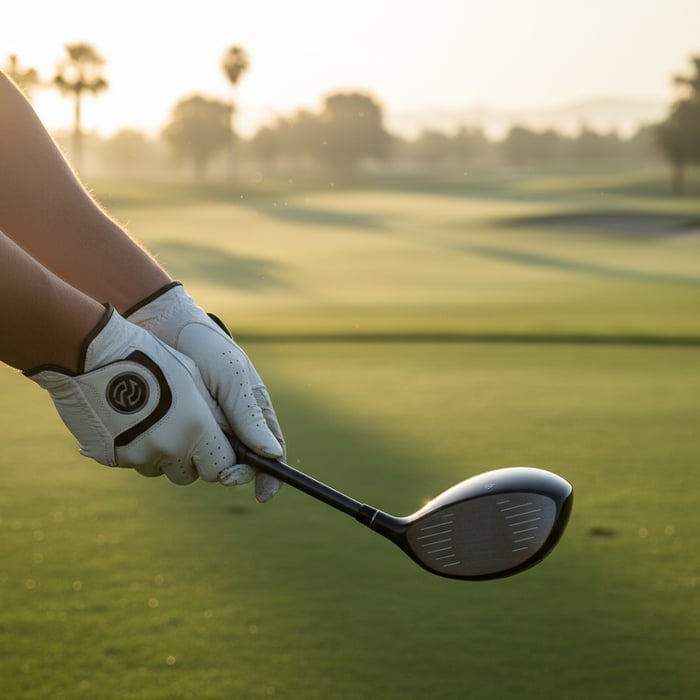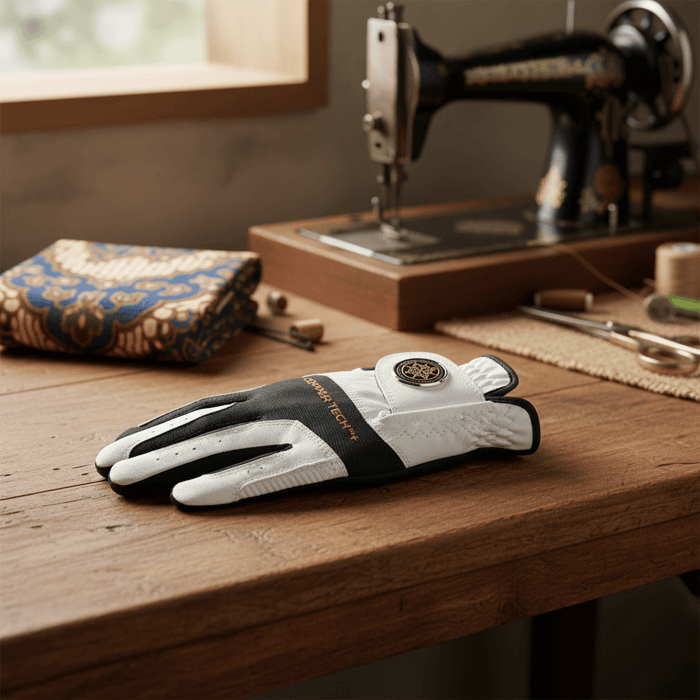Table of Contents
The Secret Killer of Your Golf Game Isn’t Your Swing Plane—It’s Your Grip. I know, that sounds crazy, but hear me out. You’re likely bleeding distance and fighting a slice, and no amount of practice on the range will fix it until you solve the one part of the club you actually touch.
You’ve probably spent a fortune on lessons, trying to perfect your backswing or your hip rotation. But that expensive driver and the hours of practice are being silently sabotaged by the ten inches of material and muscle that connect you to the club.
You treat your golf grip like a minor detail, but that oversight is the true source of inconsistent contact, frustrating pushes, and those terrible scores you see late in the round.
This isn't about getting in the gym and bulking up; it’s about consistency, control, and endurance. Mastering your grip is the simplest, most powerful way to finally unlock the better golf game you know you're capable of.
The Hidden Cost of a Wild Grip
We’ve all been there: It’s the 17th hole, the pin is tucked, and the tension in your hands is so high your knuckles are starting to turn white. This moment, when you feel you have to squeeze the life out of the club, is when everything falls apart.
This isn't just a mental hurdle; it’s a breakdown driven by one core issue: an unstable grip pressure.
Are You a Vise or a Feather? Finding the ‘Goldilocks’ Grip
Instructors often use simple advice: “Hold it like a tube of toothpaste,” or “Like a bird you don’t want to hurt.” But those analogies don't explain the critical impact—or what happens when you miss the mark.
When You Grip Too Tightly: This is the amateur’s default setting. A tight grip chokes your wrists, preventing that essential wrist-hinge and power release. It encourages an outside-in swing path, guaranteeing that dreaded slice and costing you 10-15 yards.
When You Grip Too Loosely: On the flip side, trying to be too relaxed can cause the clubface to rotate uncontrollably through impact. This leads to unpredictable hooks and pushes—the absolute definition of an inconsistent game.
The sweet spot for grip pressure is tiny. You need just enough firmness to stabilize the clubface against the powerful impact, but enough relaxation to let your wrists be quick and fluid. If you miss that balance, your best swings won't matter.
The Silent Killer: Why Your Hands Give Up on the Back Nine
Think back to your last round. Were your shots as pure and accurate on the 15th tee as they were an hour earlier?
Most of us have to admit we fade. We often blame a lack of cardio or a mental slip, but the true culprit is often simple forearm and hand fatigue.
Every powerful swing requires the small muscles in your hands and forearms to fire repeatedly to keep the club from twisting. As these muscles get tired:
You subconsciously start squeezing harder to keep control, which brings back all that destructive tension.
Your ability to stabilize the clubface weakens, meaning your contact gets messy and your shots start spraying.
This fatigue is the silent killer that turns a promising round into a frustrating finish.
What We’ve Learned About Grip Control
You’ve probably tried all the home remedies to stop slippage: special powders, extra wraps of grip tape, maybe even tried to wear two gloves at once! But the inconsistency stubbornly remains, because fighting friction with force just introduces more tension.
To truly master the grip, you need to stop focusing on what you hold with and start focusing on how your connection is supported.
The Simple Physics: Grip is Clubface Control
In golf, your grip is literally the only thing that dictates the clubface angle at impact. Period.
A strong, unwavering connection is what allows you to return that clubface squarely to the ball. If your grip shifts even slightly during the transition, the clubface will be open or closed at contact. That’s why pros spend so much time making sure their gloved hand is completely secure.
Building Endurance, Not Just Strength
Improving your golf grip is less about how much you can lift and more about building muscular endurance in the precise muscles used in the swing.
What’s the best way to train golf grip consistency?
You should focus on specific crush grip and pinch grip exercises. These directly simulate the muscle action required to keep the club steady through impact. The aim isn't maximum power; it's being able to maintain that perfect pressure for four solid hours.
Why Even the Best Technique Needs a Dependable Interface
Even if you’ve got the best swing mechanics in the world, the entire system relies on the glove. When the material stretches, wears out, or gets soaked with sweat, it allows tiny micro-slippages to occur.
These little shifts force your hands to grip harder out of fear of losing control, throwing you right back into the cycle of tension, fatigue, and inconsistency.
The Copper Tech Difference in Stability
If the biggest obstacle to scoring low is grip pressure and fatigue, then your gear must actively help solve those problems.
Standard leather gloves are passive. They stretch, they get slick when wet, and they offer zero structural support.
That’s where a new generation of gloves, like the innovative Copper Tech line, comes in. These gloves are engineered to be an active, stabilizing part of your equipment.
How Copper Tech Gloves Stabilize Pressure All Day
Copper Tech gloves are designed around one principle: promoting perfect, repeatable tension and stability.
The unique material resists the stretching and breakdown that quickly ruins traditional leather, guaranteeing a consistent fit and feel every time you put it on. That unwavering fit is the foundation for maintaining consistent grip pressure.
The engineered material works to reduce fatigue. Because it provides such a secure, non-slip surface, the Copper Tech glove allows you to hold the club with the necessary lightest pressure possible, significantly cutting down on the strain in your forearms. That means you get more energy and more control late in your round.
Tacky Secure Grip: You can relax your grip without the fear of the club moving.
Weather Consistency: The material performs just as well in dry conditions as it does when it's damp or sweaty.
Reduced Effort: You won't feel the need to “choke down” on the club, keeping your hands fresh and relaxed.
Stop fighting your glove and start letting it help you. Take a look at the full selection of Copper Tech gloves and feel what true consistency is all about.
Outperforming Leather: Your All-Weather Guarantee
In golf, reliability trumps everything. Your gear shouldn't just be decent on a perfect day; it needs to be great when the heat is on or the conditions are tough.
Unlike traditional leather, which can get rock-hard when dry or slimy when wet, the technology in Copper Tech gloves ensures their superior grip remains locked in across all conditions. That consistency breaks the entire cycle of subconsciously gripping too hard to compensate.
Longer Drives, Straighter Shots, and Less Pain
Imagine walking to the 18th tee with the same relaxed, confident grip you had at the start.
When you nail the consistency in your grip, the positive changes in your game are huge.
The Proof: What a Consistent Grip Gives You
A relaxed, reliable connection frees your body up to move correctly and powerfully. The result is:
More Distance: A relaxed grip allows the wrists to hinge and unhinge naturally, giving you maximum clubhead speed without trying.
Tighter Shot Dispersion: Your clubface returns square repeatedly, making your good shots happen more often.
Elimination of Tension-Related Mistakes: Relaxed arms and shoulders let your natural swing sequence work the way it was taught.
Reduced Hand Fatigue: You finish the round feeling strong and focused, not beat up.
The fastest, most effective change you can make today isn't another swing fix; it’s securing a dependable, non-slip grip that promotes relaxation and control.
Master your grip, and you'll master your game.


.jpg)


